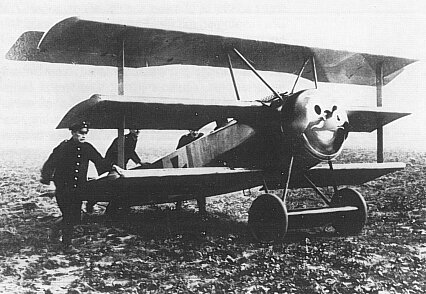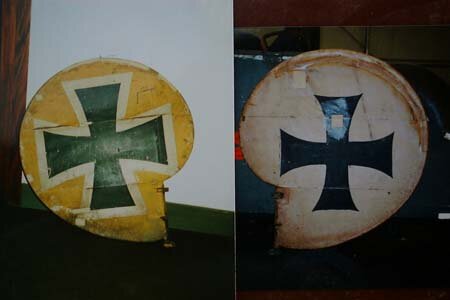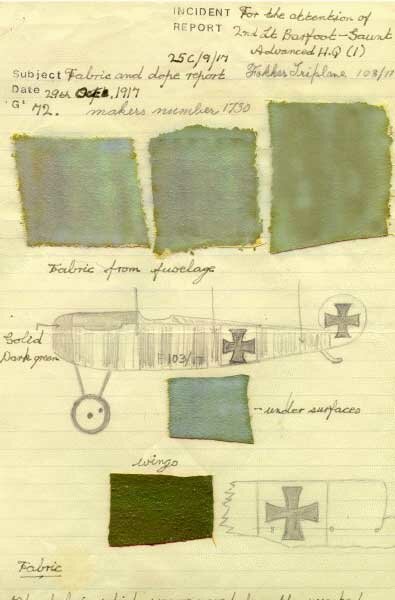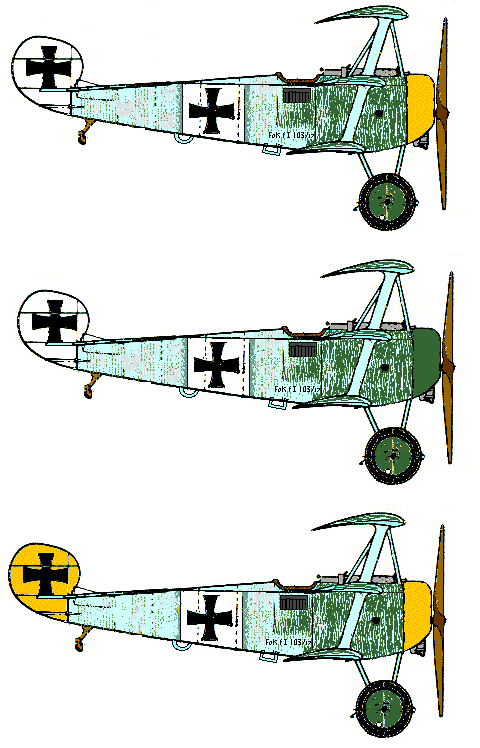The planes most likely arrived at JG1 in a standard Fokker finish. That is:
- Undersides: Aquamarine
- Top of wings and fuselage, overstreaked with Fokker's olive brown paint, according to factory.
| This camouflage style was most likely used on the two prototype Triplanes as well as later Fokker Triplanes. The over streaking was accomplished by applying olive paint using a four inch paint brush. It was done by hand, so no two planes were precisely the same. The colors of the paint may have varied, depending on the paint in stock at the factory as well as how it was applied. This may help explain why the tail of the plane seems lighter in color than the front. Because the paint was applied by hand, some areas would have better coverage than other areas, as the undercoating bled thru the top color. |
 click to enlarge
click to enlarge
|
Later, von Richthofen, may have paint the tail section and possibly the top wing of his prototype red but even this is doubtful for he barely had the plane before he went on leave and left it for Kurt Wolff to fly. Wolff would later die in a dogfight while flying FI 102/17. It is doubtful that Voß painted FI 103/17 painted silver blue.
There is speculation that Voss painted his cowl chromgelb (chrome yellow) and that Richthofen's cowl was painted red. JG1 had standing orders to paint their planes according to jasta color schemes as soon as possible. Jasta 10 aircraft had chromgelb noses.

click to enlarge
|
The only known modification to the paint scheme on Voß' plane was the funny looking face on the cowling of his DrI. Voß supposedly joked that the face was a portrait of Kaiser Wilhelm. Some authorities also speculate that the design was based on the decoration of Japanese kites, popular with the children of Krefeld, the birthplace of Voß.
It is unknown how long this face remained on the aircraft. It may or may not have remained on the aircraft until his last flight.
(see Kaiser Willy for more Information
|
While no one is 100% sure how Fok F I/103/17 was painted, the drawings, photographs, and documentary evidence suggests:
- The cowl is probably olive but may have been painted chromgelb before the last dog fight.
- The top surface of fuselage heavily streaked with olive almost obscuring the entire under color.
- Sides of the fuselage are heavily streaked towards the front of the aircraft with lighter streaking as you move to the tail section.
- Wing surfaces:
- Top: heavily streaked with factory olive
-
Lower: aquamarine
- Large white squares painted around the maltese crosses
- Crosses on the bottom wing may lack the white border.
- Rudder: White with black cross.
The Rudder
 click to enlarge
click to enlarge
|
To the left is a chrome yellow tail rudder that was given to the Imperial War Museum. However, it is doubtful the rudder is actually from Voß's plane. While it is true that Jasta 10 flew aircraft with chrome yellow tails, this rudder is from a late production Fokker DrI. This is only one reason why it is doubtful the tail is from Voß's plane. Voß plane went down in no man's land and was eventually recovered by the British.
Also note that in all known photographs, the tail appears to be one universal light color (white) with a black cross. This rudder shows dark yellow with a white trim around the black cross. One theory suggests that the film used at the time made chrome yellow appear dark, almost black. If this were the case then the entire tail should appear on photographs as almost black with an outline of maltese cross in black. There are no known photographs depicting such a color scheme.
What is known, is this rudder was donated by the Rhys Davids family to the Imperial War Museum under the assumption it was from Voß's plane. Members of 56 Squadron gave the rudder to the Rhys-Davids family some time after he was killed in action.
The rudder given to the Rhys Davids family was described as white with a black cross.
And finally I received this message from Axel Revell, a noted Author/historian on World War I aircraft:
I've have been reading the excellent page on Voss. May I comment on the colour of Voss's rudder on 103/17.
The rudder was sent to Rhys Davids (please note, no hyphen!)mother by the commanding officer of 56 Squadron in July 1918.
He describes it in his letter to her as white, with nine bullet holes, three unpatched. The yellow painted rudder in the IWM is not the rudder from 103/17.
Mrs RD donated the Voss rudder to the IWM in 1920. It was later returned to the family and then re-donated in the late 70s. It is probably still in the depths of the IWM but has not yet been found.
Alex Revell
|
The Reports
Finally we have information from two British Intelligence reports regarding the wreckage of Voß' Dreidecker. Report one clearly gives the color scheme of the plane and This report may or may not be a fraud.
Many but not all Barfoot-Saunt Intelligence reports were largely discounted as frauds in the early 1990s. The reports attributed to the late Rodney Gerrard were exposed as frauds by Alan Toelle. However many actual reports submitted by Barfoot-Saunt are filed with the British Government are are factual.
See: Cross & Cockade 26:3,1995
Report 1:
Incident Report
To Lieut Barfoot-Saunt
Wing Intelligence, Area HQ
Subject: Fokker Triplane which was shot down by a flight of SE5s.
Total wreck. Number 103/17.
Date: September 1917
Details
Little of this machine is intact to enable a fully detailed description at this time but the following points are worthy of note. The machine is one of the new Triplane "Scouts" which have been reported active in the Sector during the past four weeks. The fuselage is of alloy tubing covered with fabric whilst the wings are of wood fabric covered. The Le Rhône engine is covered with a cowling or rather partly covered as the cowl is not a full one, possibly to assist cooling as are the two holes in the front/top of same.
The machine features a new attempt by the enemy at camouflage The entire upper and sides surfaces are doped in various shades of green blue and grey which takes the form of streaks applied at various angles: vertical on the fuselage and slanted on the tail. The upper and second wing has not been salved but the streaks on the bottom wing are just off the vertical slanting slightly to the left. Lower surfaces are a greyish blue. Upper surface dope is of poor quality but the fabric is good.
Area Intelligence Officer
|
|
This second report is clearly a fraud. Note that the upper and middle wing were not "salved" or recovered, yet there is a sketch of the right upper wing. Also note that the aileron on the upper wing is a sketch of a later model Dr I and not of the earlier models or the prototype.
The author also states it is one of the triplane scouts active in the area. Most likely, at the time of Voß death his triplane was probably the only triplane as Wolff had already died and no production triplanes had been sent from the factory yet.
Report 2: 
|
Return to the Dreidecker Page

|




